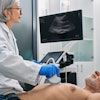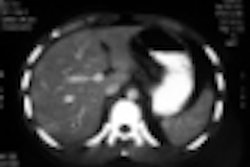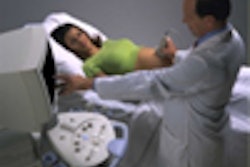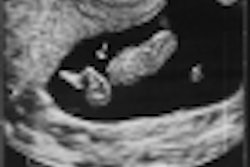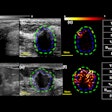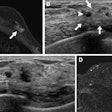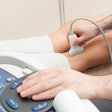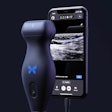An increased incidence of ectopic pregnancy over the past few decades has corresponded with an increase in assisted fertilization procedures and Caesarian deliveries, as well as a rise in pelvic inflammatory disease. At the same time, improved clinical management and the use of increasingly accurate and reliable ultrasound exams for diagnosis have lowered mortality rates associated with ectopic pregnancy.
Dr. Edward Lyons presented a synopsis of new sonographic signs for ectopic pregnancy diagnosis at the 2001 Australian Society for Ultrasound in Medicine meeting in Sydney. Lyons is a professor of radiology, obstetrics, and gynecology at the University of Manitoba in Winnipeg, Canada.
Ultrasound has emerged as an extremely useful diagnostic tool for women with a positive pregnancy test who develop lower abdominal pain and vaginal bleeding, according to Lyons.
"The classical triad of pain, vaginal bleeding, and a palpable adnexal mass is present in only 9% of patients with ectopic pregnancy, and the positive predictive value of this triad is only 14%," he said. Alternate gynecological problems in this group of women include symptomatic ovarian cyst, pelvic inflammatory disease, dysfunctional bleeding, and spontaneous abortion.
The development and widespread utilization of transvaginal ultrasound also has improved the early diagnosis of extrauterine pregnancies. Transvaginal ultrasound affords higher resolution and enables differentiation of a normal double decidual sign from the decidual cast associated with extrauterine pregnancies.
"A decidual cast is an intrauterine fluid collection surrounded by a single decidual layer, as opposed to the two concentric rings of the double decidual sign," Lyons said.
In a retrospective study from Lyon’s department, which followed 200 women with a confirmed ectopic pregnancy, a live ectopic pregnancy was demonstrated in only 12% of cases. According to Lyons, "the sonographic demonstration of a live embryo in the adnexa is specific for the diagnosis of ectopic pregnancy."
The demonstration of an adnexal mass or trophoblastic ring, in the absence of an intrauterine gestation sac and positive beta hCG, is also strongly suggestive of an ectopic pregnancy.
Color Doppler has expanded the range of ultrasound findings for early normal and ectopic pregnancies. Peritrophoblastic flow, characterized by high arterial velocities and a low resistance waveform, accompany the early development of a gestational sac. Bright color signals in the sentinel vessels as early as four weeks indicate an intrauterine gestation, and this is a useful ultrasound sign if a gestation sac is not yet seen.
Free fluid in the pelvis is an important nonspecific finding in ectopic pregnancy, and transvaginal ultrasound is particularly good at demonstrating free pelvic fluid. Hemoperitoneum (echogenic fluid) or blood clots in the cul-de-sac will accompany a ruptured ectopic pregnancy. In their study, transvaginal ultrasound showed echogenic free fluid in 79% of cases. However, free fluid was found in 37% of cases without ectopic rupture, Lyons said. As a result, free fluid is a specific but not a sensitive sign for ectopic rupture, he added.
Determining whether an ectopic pregnancy is located within the isthmus or interstitial portion of the fallopian tube is an important diagnostic challenge because treatment options differ depending on the position.
Fortunately, 95% of ectopic pregnancies are located in the isthmic or ampullary part of the tube, and these can be dissected and removed at laparoscopy. Patients with interstitial ectopics require cornual resection; these masses tend to be very vascular, according to Lyons.
So how can ultrasound be used to differentiate these symptoms? Lyons explained that an interstitial ectopic has no double-line sign surrounding it as endometrium surrounds the gestation sac. Instead, ultrasound will demonstrate a very thin echogenic line connecting the endometrium and the mass, with associated localized myometrial thinning. Only 2.3% of ectopics in the study were interstitial in location.
Lyons cautioned against confusing a cornual ectopic pregnancy with one in the interstitial portion of the tube. He said that a cornual ectopic is merely an eccentric implantation within the endometrial canal, and the pregnancy should progress normally without ill effect.
A decidual cyst in the basal endometrium is another early suggestive sign of an ectopic pregnancy. These cysts do not have a trophoblastic rim, and so ultrasound won’t demonstrate a second echogenic ring. Decidual cysts have no associated blood flow, so color Doppler is used for differentiation from an early gestation sac.
The study revealed a decidual cyst in 14.5% of patients with an ectopic pregnancy at 6.4 weeks, and this was the only sign in 12 patients on their first ultrasound examination. These cysts may occur around four weeks in a normal pregnancy, so if this is found at that stage, a repeat scan with careful attention to the adnexa should be performed.
"A decidual cyst rings a bell when you might not otherwise suspect an ectopic and is superb when it’s present," Lyons said.
He concluded with a reminder that while 1 in 600 ectopic pregnancies are heterotopic, this figure increases to 1 in 100 for women undergoing in vitro fertilization treatment.
By Leanne McKnoultyAuntMinnie.com contributing writer
October 10, 2001
Leanne McKnoulty is an accredited medical sonographer currently lecturing in ultrasound at Monash University in Melbourne, Australia. She also is an editor at Ultrasound Review.
Copyright © 2001 AuntMinnie.com



